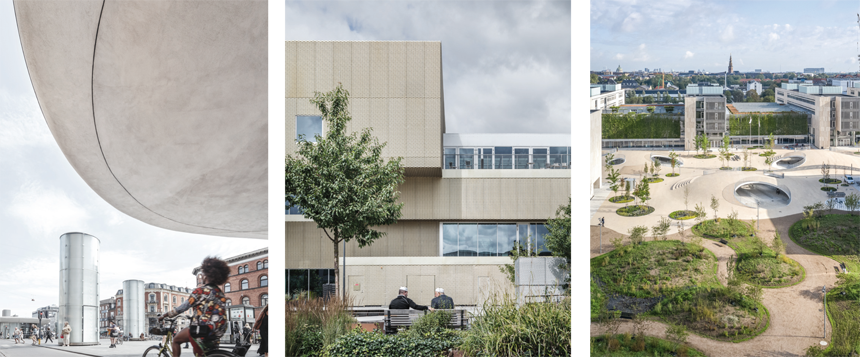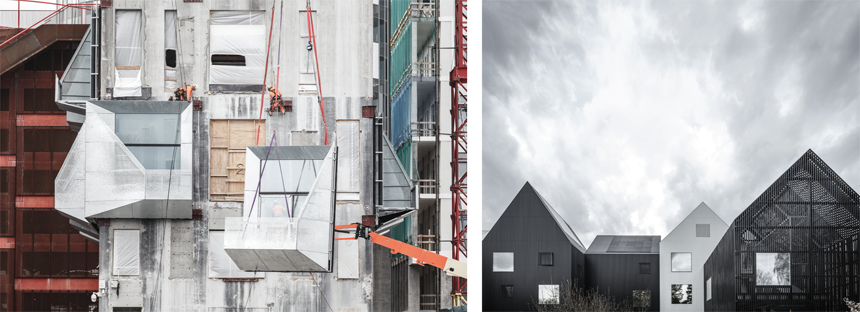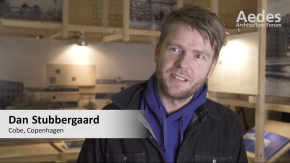Video Guided Exhibiton Tour ►
Das dänische Büro Cobe zählt zu den renommiertesten Vertretern einer neuen Architektengeneration. Mit innovativen Methoden erforscht das Team um Dan Stubbergaard die vielfältigen Potenziale des städtischen Raums und setzt sie in außergewöhnlichen Projekten um. Cobe versteht die Stadt als erweiterten Wohnbereich, in dem sich privater und öffentlicher Raum auf experimentelle Art miteinander verbinden lassen – urbane Lebensqualität ist somit ein zentrales Thema des Büros. Our Urban Living Room präsentiert eine Auswahl realisierter Projekte in Kopenhagen aus den letzten 13 Jahren, darunter der öffentliche Raum Karen Blixens Plads, das Wohnhochhaus The Silo und der Frederiksvej Kindergarten. In einer raumgreifenden Holzinstallation erzählt die Ausstellung anhand vielfältiger Medien zudem von der architektonischen Entwicklung Kopenhagens und geht darauf ein, wie sich diese Veränderungen auf den Alltag der Menschen und ihre sozialen Interaktionen auswirken.
In den letzten 30 Jahren hat sich die dänische Hauptstadt Kopenhagen sehr verändert: Aus einer von der Industrie geprägten Hafenstadt wurde eine lebenswerte, fahrradfreundliche Metropole, die sich als Experimentierfeld für nachhaltige Stadtentwicklung und zukunftsweisende Architektur etabliert hat.

Nørreport Station | The Library | Karen Blixens Plads in Copenhagen. © Rasmus Hjortshøj - COAST and Cobe
„Unsere Stadt ist unser Zuhause, und genau darauf baut der Erfolg Kopenhagens heute auf. Je mehr uns als Architekten, aber vor allem als Bewohner Kopenhagens an der Stadt liegt, desto besser werden wir mit ihr umgehen. Je besser die Gestaltung unserer Stadt ist, desto mehr Menschen werden hier gut leben wollen und stolz darauf sein. Dabei geht es nicht um Schönheit, Eleganz oder Reichtum, sondern um Lebensqualität und städtische Demokratie“, erläutert Dan Stubbergaard, Architekt und Gründer von Cobe.
Our Urban Living Room widmet sich den Kopenhagener Architekturprojekten von Cobe und ist Ausstellung sowie architektonische Intervention in einem: anhand von Modellen, Bildern, Texten und Zeichnungen lädt eine raumgreifende, komplexe Regalstruktur dazu ein, sich den umgesetzten Projekten zu nähern.
Die Regalstruktur bildet den Rahmen für die Präsentation von sieben Themen, darunter die Umnutzung von Industriebauten, Architektur für Kinder und die Frage, wie Kopenhagen in Zukunft aussehen könnte. Durch die Konzeption der Ausstellung mit spielerischen und interaktiven Elementen werden die Besucher in die Definition des urbanen Wohnraums eingebunden und können damit hier, bei Aedes in Berlin, von Kopenhagen lernen.
Our Urban Living Room wurde von Cobe in Zusammenarbeit mit dem Dansk Arkitektur Center (DAC) in Kopenhagen konzipiert und 2016 erstmals im DAC sowie 2018 im städtebaulichen Informationszentrum Laituri in Helsinki gezeigt. Für die Präsentation in Berlin wurde die Ausstellung von Cobe gemeinsam mit dem Aedes Architekturforum weiterentwickelt.

The Silo | Frederiksvej Kindergarten in Kopenhagen. © Rasmus Hjortshøj - COAST und Cobe
Über Cobe
Cobe wurde 2006 von dem Architekten Dan Stubbergaard gegründet. Das Büro mit Sitz in Kopenhagen, Dänemark spielt seitdem eine wichtige Rolle bei der Transformation der dänischen Hauptstadt hin zu einem dynamischen, demokratischen, lebenswerten Ort. Derzeit ist das Büro an zahlreichen Projekten in ganz Europa und in Nordamerika beteiligt. Zu den markantesten Projekten des Büros gehören Nørreport Station, Kopenhagens zentraler Verkehrsknotenpunkt, The Silo und die Planung des neuen Kopenhagener Stadtteils Nordhavn, des bisher größten Stadtentwicklungsprojekts Skandinaviens, Ragnarock, Dänemarks Museum für Rockmusik in Roskilde, und die Entwicklung des Areals Papirøen in Kopenhagen.
Cobe in Deutschland
Neben zahlreichen Projekten in Kopenhagen realisierte Cobe in den letzten Jahren vermehrt auch Arbeiten in anderen Ländern, vor allem in Deutschland. Dazu gehören unter anderem das 2018 am Firmensitz von adidas in Herzogenaurach eröffnete adidas HALFTIME, ein Begegnungsort und Konferenzzentrum für Mitarbeiter, Besucher und Markenbotschafter von adidas, die städtebauliche Entwicklung des früheren Kölner Industriehafens Deutzer Hafen und der Europahafenkopf im ehemaligen Bremer Industriehafen, wo derzeit Gebäude für unterschiedliche Nutzungen entstehen.
Projects
Nørreport Station
Year: First prize in competition 2009, completed 2015
Client: City of Copenhagen, Banedanmark and DSB
Programme: Urban plaza and renovation of existing train station
Size: 10,500 m² with 2,500 parking lots for bicycles
Nørreport Station is the busiest train station in Denmark, with more than 250,000 people passing through it daily. Since the 1960s, the bustling station developed into a vast and chaotic intersection in the middle of the city. The new station is composed of a series of rounded, floating roofs, mounted on distinctive glass pavilions. A study of pedestrians’ preferred routes formed the basis of the station’s new design, providing an open and welcoming public space with specific consideration for the needs of cyclists and pedestrians. Nørreport Station is not only a station but also an urban landscape for people. It transforms Copenhagen’s busiest space into a single unified flow and becomes an integrated part of the pulsating city around it.
Krøyers Plads
Year: Commissioned 2011, completed 2016
Client: Bonava
Programme: Residential and retail
Size: 20,000 m²
The Krøyers Plads site has been an architectural and political battlefield for more than a decade. Over the years, local organizations and politicians have rejected five architectural proposals for various reasons, until Cobe’s and Vilhelm Lauritzen Architects' final building design for this beautiful historical site on the Christianshavn harbour front was approved. The design is based on a hyper-democratic and contextual approach – an architectural storytelling approach that strives to create a meaningful and comprehensive infill through dialogue with the local community. Rather than inventing a new building type, Krøyers Plads is a reinvention of the industrial warehouse adjacent to the site. The new Krøyers Plads thus consists of three residential warehouses that fit into the existing environment, based on insights gathered from locals living in the neighbourhood.
The Library
Year: First prize in competition 2009, completion 2011
Client: City of Copenhagen
Programme: Extension of existing culture house including new library and concert hall
Size: Existing 1,150 m², new build 2,000 m²
In Copenhagen’s multicultural Northwest district, the social hub is a library designed as a diverse and unifying space – a place where visitors can read, play with their children, meet new friends or simply relax. The building is an extension of an existing cultural centre, with a library and concert hall that together form a community centre. The design is inspired by a stack of books. Each “book” contains a different aspect of the building, a structure that is meant to appeal to a diversity of people. In the void between the “books” and the old cultural centre, this space transforms the library corridors into a welcoming informal meeting place inside the building. It functions as a social hangout for visitors and residents in the Northwest district.
Frederiksvej Kindergarten
Year: First prize in competition 2011, completed 2015
Client: City of Frederiksberg
Programme: Day care center for 182 children, age 0-6
Size: 1,700 m²
At its core, a kindergarten is about creating a safe, playful and inspiring setting for kids to grow up in. The starting point for this kindergarten was to create a building from the eye level of a child. The design is based on a concept that kids are very fond of: The playhouse. As a series of small houses within a bigger house, the interior of the kindergarten is composed of several small and different worlds that vary in size and function. A house within a house becomes a recurring motif, both indoors and out. The aim is to create architecture that is comprehensible in the eyes of a child and to draw inspiration from the simplicity and purity of a child’s drawing. The result is a scaled-down environment consisting of many different worlds, but also a place where kids can feel a sense of belonging to one specific house within the cluster of houses.
The Silo
Year: Commissioned 2013, completed 2017
Client: Klaus Kastbjerg and NRE Denmark
Programme: Former grain silo transformed into residential complex and public facilities
Size: 10,000 m²
The 17-storey former grain silo is a natural point of orientation in Copenhagen’s new neigbourhood Nordhavn. The spatial variation within the original silo is immense due to the various functions of storing and handling grain, creating space for 39 unique apartments. Single and multi-level apartments range from 73 m² to 305 m² in size with floor heights of up to seven meters. Both the top and lower levels have public access, to ensure a multi-dimensional experience for the various users of the building. The Silo is inhabited, but also a destination. An urban focal point for the redeveloped Nordhavn area.
Nordhavn
Year: First prize in competition 2008, on-going, under construction
Client: CPH City & Port Development
Programme: Masterplan for new city district in former industrial harbour area, including development plan, district plans, design of public spaces, streetscapes and promenades, landscaping, bicycle infrastructure and metro stations
Size: 3.6m m²
Future environmental challenges must be solved through a sustainable approach to city planning. The transformation of Nordhavn (North Harbour) – the largest metropolitan development in northern Europe – continues Copenhagen’s historic strategy of a step-by-step expansion into the surrounding sea. The new Nordhavn is conceived as an urban archipelago or a series of dense neighbourhoods on the water. Planning one island at a time, the Nordhavn master plan is not an ideal city vision, specifying every last detail, but rather a robust and flexible guideline intended to inspire future generations of urban planners. It is a way of addressing one of the great challenges of city planning: Designing for the needs and demands of today while trying to predict and address the major environmental challenges shaping our future. As the first DGNB platinum-certified urban area in Denmark, the Nordhavn project takes a holistic approach to urban planning.
SPONSOREN
Dreyers Fond, Tømmerhandel Johannes Fogs Fund, Knud Højgaards Fond, KUKURUZ

DANK AN









